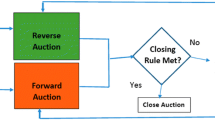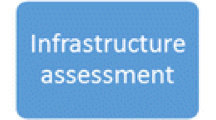Abstract
Researchers have cogently presented the technical case for converged telecommunications systems. However, it is not clear how market-based telecommunications providers and local communities are embracing this technical argument as they design and adopt new telecommunication systems. This paper uses a case study approach to examine market and policy dynamics influencing converged network deployment in a mixed commercial and residential environment. Specifically, the article presents the overall telecommunications design and then analyzes several implementation alternatives proposed for a major urban redevelopment project in the greater Denver metropolitan area. These alternatives range from more traditional telecommunications solutions to fully converged networks. Based on this review, the paper analyzes the role of a layered policy approach to telecommunications regulation at the local level and how interoperability serves as a mediating condition before market convergence is achieved. Finally, the paper addresses public policy implications for encouraging adoption of fiber-IP based networks as well as research directions for assessing metropolitan adoption of converged systems.
Similar content being viewed by others
References
Association for Local Telecommunications Services (ALTS). ALTS Annual Report: The State of Local Competition 2002. ALTS, Washington, D.C., April 2002. Location: http://www.alts.org/ Filings/2002AnnualReport.ppt.
Baumgartner J. Carnegie Mellon, 3 Rivers Propose Affordable Broadband Measures. Communications, Engineering and Design, April 24, 2002. Location: http://www.broadbandweek.com/news/ 020422/020424 biz carnegie.htm.
Berquist L, Grant A. The emerging municipal information infrastructure. In: Hurley D, Keller JH, eds. The First 100 Feet. Cambridge, MA: MIT Press, 1999:173–194.
Cahners In-stat Group. MTU Update: Growth Spurts in an Infant Market. Dec. 2000, Report no. RC00-10AC, 1-60.
Chatterjee S, Byun J. Network convergence: Where is the value? Communications of the AIS 2002;9:421–440.
City of Palo Alto, FTTH Trial. City of Palo Alto, Palo Alto, CA., 2001. Location: http://www.cpau.com/fth.
Cohill A, Kavanaugh. Community Networks: Lessons from Blacksburg, 2nd ed. Virginia, Boston, MA: Artech House, 2000.
Comer DE. Internetworking with TCP/IP: Vol. 1, Principles, Protocols, and Architectures: 4:e. Upper Saddle River, NJ: Prentice Hall, 2000.
Cravens A. A BLEC resurrection? Communications, Engineering and Design. Cahners Instat Group, Jan. 2002. Location: http://www.cedmagazine.com/ced/2002/0102/id3.htm
Federal Communications Commission (FCC). Third Report: Inquiry Concerning the Deployment of Advanced Telecommunications. Federal Communications Commission,Washington D.C., Rep.CC Docket 98-146. Feb. 6, 2002.
Ferguson CH. The U.S. broadband problem. The Brookings Institution Policy Brief, Policy Brief #105, July 2002. Location: http://www.brook.edu/comm/policybriefs/pb105.htm.
Frieden R. Adjusting the horizontal and vertical in telecommunications regulation: A comparison of the traditional and a new layered approach. In: Presented at the 30th Research Conference on Communication, Information and Internet Policy. Alexandria,VA, Sept. 28-30, 2002.
Gabel D. Why is there so little competition in the provision of local telecommunications services? In: Presented at the 30th Research Conference on Communication, Information and Internet Policy. Alexandria, VA, Sept. 28-30, 2002.
Gabel D, Mueller M. Household financing of the first 100 feet. In: Hurley D, Keller JH, eds. The First 100 Feet. Cambridge, MA: MIT Press, 1999:11–23.
Gerovac B, Carver D. Delivering on the promise: Scenarios for deploying local access. In: Hurley D, Keller JH, eds. The First 100 Fee t. Cambridge, MA: MIT Press, 1999:24–38.
Horan T. Digital Places: Building our City of Bits.Washington, D.C.: The Urban Land Institute, 2000.
Housel TJ, Skopec E. Global Telecommunications Revolution: The Business Perspective.New York, NY: McGraw-Hill, 2001:73-99, 262–279.
Kennard WE. Strategic Plan: A New FCC for the 21st Century. Federal Communications Commission, Aug. 1999. Location: http://www.fcc.gov/21st century/draft strategic plan.pdf.
Lapuerta C, TyeWB. Promoting effective competition through interconnection policy. Telecommunicaitons Policy 1999;23:129–145.
Lehr WH, Glassman JK. The Economics of the Tauzin-Dingell Bill: Theory and Evidence. Working paper from the MIT School of Management. Paper 128, June 2001.
Mansell R, Steinmueller EW. Mobilizing the Information Society. New York: Oxford University Press, 2000:99–149.
Mercer D. DSL DTV: Status and prospects. Strategy Analytics Inc., London, UK, July 2001.
National Research Council (NRC). Computer Science and Telecommunications Board, Committee on Broadband Last Mile Technology. Broadband: Bringing Home the Bits. National Academy Press, 2002.
Noam EM. Interconnecting the Network of Networks. Cambridge, MA: MIT Press, 2001:1–16.
O'Donnell S. Broadband architectures, ISP business plans, and open access. In: Presented at the 28th Telecommunications Policy Research Conference. Alexandria, VA., Sept. 23-25, 2000.
Palmer K. A test for cross subsidies in local telephone rates: Do business customers subsidize residential customers. RAND Journal of Economics 1992;23(3).
Pool I. de S. Technologies of Freedom. Cambridge, MA: Harvard University Press, 1983.
Poulton K. The Palo Alto fiber to the home Trial: A work in progress. Palo Alto Fiber Network Utility. Palo Alto, CA., 1999. Location: http://www.canarie.ca/press/publications/pdf/workshop99/ poulton.pdf.
Saltzer J, Reed D, Clark D. End-to-end arguments in system design. ACM Transactions in Computer Systems 1984;2:277–288.
Sicker D. Applying a layered policy model to IP based voice services. In: Presented at the 36th Hawaii International Conference on System Sciences, 2003.
SweetW, Bretz E. How to make deregulation work. IEEE Spectrum Jan. 2002:50–56.
Telecommunications Act of 1996, Pub. LA. No. 104-104, 110 Stat. 56, 1996. Federal Communications Commission. Location: http://www.fcc.gov/Reports/tcom1996.pdf.
Thorne J. The 1996 Telecom Act: What went wrong and protecting the broadband build out. In: Presented at the Columbia University Conference: The Broadband Economy, Sept. 2001.
Wanichkorn K, Sirbu M. The role of fixed wireless access networks in the deployment of broadband services and competition in local telecommunications markets:Anengineering, economic, and public policy analysis. In: Presented at the 30th Research Conference on Communication, Information and Internet Policy. Alexandria, VA, Sept. 28-30, 2002.
Werback K. A layered model for Internet policy. In: Presented at the 28th Telecommunications Policy Research Conference. Alexandria, VA, Sept. 23-25, 2000.
Author information
Authors and Affiliations
Rights and permissions
About this article
Cite this article
Horan, T.A., Schooley, B.L. Market Dynamics and Local Policy Choices for Converged Systems: Case Study of Integrated Telecommunication Design and Deployment. Information Systems Frontiers 6, 205–218 (2004). https://doi.org/10.1023/B:ISFI.0000037876.19081.e9
Issue Date:
DOI: https://doi.org/10.1023/B:ISFI.0000037876.19081.e9




